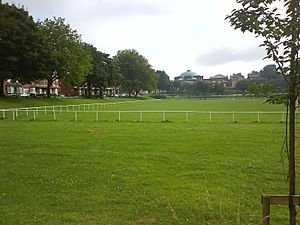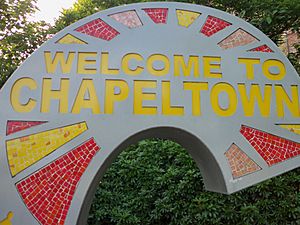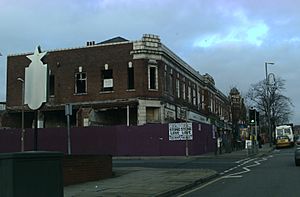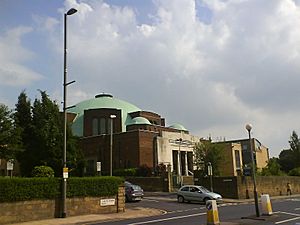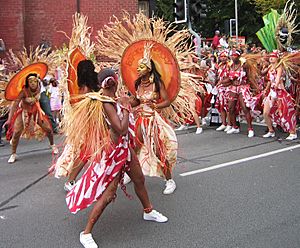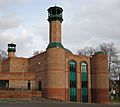Chapeltown, Leeds facts for kids
Quick facts for kids Chapeltown |
|
|---|---|
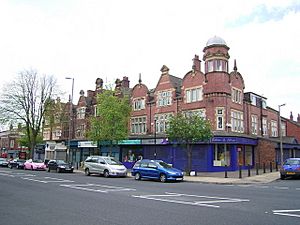 Chapeltown Road |
|
| OS grid reference | SE3093435637 |
| Metropolitan borough | |
| Metropolitan county | |
| Region | |
| Country | England |
| Sovereign state | United Kingdom |
| Post town | LEEDS |
| Postcode district | LS7 |
| Dialling code | 0113 |
| Police | West Yorkshire |
| Fire | West Yorkshire |
| Ambulance | Yorkshire |
| EU Parliament | Yorkshire and the Humber |
| UK Parliament |
|
Chapeltown is a lively area located in the north-east part of Leeds, a big city in West Yorkshire, England. It's about one mile north of the very center of Leeds. Chapeltown is part of the Leeds City Council area called Chapel Allerton.
Contents
Where is Chapeltown Located?
Chapeltown doesn't have exact, official borders. It's not recognized by official groups like the Land Registry or the Post Office. However, people who live in Leeds know where Chapeltown is.
The Ordnance Survey, which makes maps, sees Chapeltown as a smaller area. It's around specific map coordinates, north of Harehills Lane and east of Harrogate Road. Chapeltown Road leads to Chapeltown, but it isn't entirely within it.
Some people think Chapeltown covers a wider area. This includes parts of the LS7 postal region. This larger area is similar to the boundary used in the Leeds Index of Deprivation. However, most people agree that Markham Avenue and Gathorne Terrace divide Chapeltown from Harehills. Harehills is right next door, and people often talk about the two areas together.
Chapeltown is surrounded by other areas in Leeds. To the north is Chapel Allerton. To the west is Scott Hall, which the council considers part of Meanwood. Harehills is to the east, and Sheepscar is to the south. Potternewton is either to the north or included within Chapeltown.
The main road in Chapeltown is Chapeltown Road. It runs north-south through the middle of the area for about 2 miles (3.2 km). This road connects Sheepscar Interchange, which is near Leeds city center, to Harehills Lane and Chapel Allerton.
Chapeltown and Potternewton: Are They the Same?
Sometimes, the names Chapeltown and Potternewton are used for the same place. Potternewton is an old village. Many maps show Potternewton as the main name. But most people in Leeds call the area Chapeltown.
Potternewton Park is a large and beautiful park in the north-east of the area. It's famous for being the starting point of the Leeds Carnival. This is Europe's oldest West Indian Carnival!
Norma Hutchinson Park is a smaller park with a playground and sports field. It's in the south of Chapeltown. It used to be called Buslingthorpe Recreation Ground. In 2009, it was renamed to honor Norma Hutchinson. She was a local councilor from Jamaica who passed away in 2004.
Getting Around Chapeltown
Chapeltown has good bus services. Buses 2, 3, 3A, and 36 run directly through the center of the area on Chapeltown Road. There's also an hourly service 48, but it doesn't run in the evenings or on Sundays. Bus service 91 runs along Harehills Lane. School buses also go through Chapeltown. They connect to high schools like Cardinal Heenan, Carr Manor, and Boston Spa.
Schools in Chapeltown
There are several schools in Chapeltown. Bracken Edge Primary School is next to Potternewton Park. It was rebuilt and made bigger in 2007. Hillcrest Primary School is another important school in the area. It has hosted special events like "Playing for Success."
Holy Rosary and St Annes Catholic School is on Leopold Street. Leopold Primary School, which was also on Leopold Street, closed in 2002 because it was too crowded. It is now the Chapeltown Children Centre. Chapeltown Community Nursery is located on Reginald Street.
A Look Back at Chapeltown's History
The name Chapeltown comes from Chapel Allerton. It was first used in 1427. In 1715, a writer named Ralph Thoresby described Chapel-Town as a nice place with "pure Air" and great views. The open land to the east and north of Potternewton was called "Chapel-Town Moor."
Chapeltown Moor was a large open space, about 300 acres. It was used for horse races and archery contests. In 1765, one of the first known cricket matches in Yorkshire happened here. It was between "the Gentlemen of Chapeltown and the Gentlemen of Sheffield." By 1809, most of this open land was fenced off.
In the 1800s, Chapeltown started to become a wealthy suburb. Many large houses and terraces from this time still exist. Some of these big houses are now divided into smaller, cheaper apartments. However, the area still has lots of trees and interesting old buildings. Over the years, different communities have moved to Chapeltown. They have changed buildings to use them as places of worship and for social gatherings. For example, the Union Chapel on Chapeltown Road became a synagogue, then a Sikh temple. It's now empty after being damaged by fire. Chapeltown Barracks, a military building, was finished in 1820.
How Chapeltown Was Built
A map of Leeds from 1834 shows that the area now known as Chapeltown was farmland. It was located between the villages of Chapel Allerton and Potternewton and the city of Leeds. The Leeds-Harrogate Turnpike Road, which later became Chapeltown Road, ran through this farmland. This land was already planned to be a new suburb of Leeds.
Much of this land, called 'Squire's Pastures', belonged to Earl Cowper. The Earl first tried to sell this land for building in 1825. But planning and building took a long time, and the sale wasn't completed until 1873. Before selling, the Earl made rules about what could be built. He wanted the area to be residential, meaning mostly homes. He limited things like farm animals, heavy factories, and pubs.
By 1866, the area east of Chapeltown Road and north of Roundhay Road had many nice houses. These were built for the growing middle class and were known as New Leeds.
Further north, near Potternewton, building started in 1856 on Newton Grove. The Lupton family continued building on their Newton Park Estate. They used designs by Charles Chorley and John Connon. The area kept growing, and by the 1880s, Sholebroke Avenue was added south of the Newton Park Estate.
In the next ten years, Chapeltown became less popular. People preferred areas further from the city. The empty plots of land were then filled with smaller, cheaper terraced houses. By the early 1900s, almost all the land in Chapeltown had houses on it.
The Lupton family's home, Newton Hall, was torn down in the 1920s. Streets of semi-detached houses were built on its land.
Not much building happened in Chapeltown during the 1900s. Unlike many other areas, its older houses were not torn down to make way for new ones. This might be because the houses were well-built. They were originally made for the new middle class of Leeds during the Industrial Revolution.
Who Lives in Chapeltown?
Throughout its history, Chapeltown has been home to many different groups of people who have moved there. Each group has added to the area's culture, religions, and heritage.
Ashkenazi Jews came to Leeds from Eastern Europe in the late 1800s. They were escaping difficult situations called pogroms. Many of them settled in the inner-city area of the Leylands. Later, many Jewish families moved north to the nicer area of New Leeds/Chapeltown. Synagogues, which are Jewish places of worship, also moved there. At one point, there were 14 synagogues in Chapeltown! This area, along with nearby Harehills, was a big center for tailoring and clothing businesses. Many Jewish people worked in these trades. The street name Button Hill still reminds us of this history.
In 1932, the Chapeltown Road New Synagogue opened. It was a large building with a dome. The artist David Hillman designed three stained-glass windows for the synagogue in 1935. These windows are now at Shadwell Lane Synagogue. In the following decades, the Jewish population in Chapeltown started to get smaller. Many families moved further north to the Moortown area. In 1985, the synagogue closed. The Leeds City Council bought the building. It is now home to the Northern School of Contemporary Dance.
Many people from the British African-Caribbean community in Leeds came to the UK after World War II and in the early 1960s. Some of the first Jamaicans to settle in Leeds were ex-soldiers. To encourage people from the British Empire and Commonwealth countries to come and work, the 1948 British Nationality Act gave British citizenship to everyone in Commonwealth countries. This also gave them full rights to enter and live in Britain. Many of the first generation of Jamaicans living in Chapeltown today moved during this time. The Jamaica Society was formed. Its office was at 277 Chapeltown Road. It was created to help and celebrate the African-Caribbean people in West Yorkshire and Leeds.
Culture and Community in Chapeltown
Chapeltown is home to many community and creative groups. These include the Northern School of Contemporary Dance, the Chapeltown house choir, the Host Media center, and Leeds West Indian Centre. The West Indian Centre is now famous for its club nights, especially the monthly SubDub.
Chapel Allerton Hospital is located in Chapeltown. It is one of Leeds' main hospitals, but it does not have an emergency room.
Leeds Carnival: A Big Celebration!
Every August bank holiday weekend, Chapeltown hosts the Leeds Carnival. This carnival is the second largest in the UK, after London's Notting Hill Carnival. However, Leeds Carnival actually started in 1967, before Notting Hill's.
Arthur France, a student from Saint Kitts at Leeds University, helped organize the first West Indian Carnival in Britain in Leeds in 1967. That year, Vicki Celto was the first Carnival Queen for Leeds. Her costume was called "Sun Goddess."
Northern School of Contemporary Dance (NSCD)
The NSCD is a modern dance school. It started from dance education programs in Leeds in the 1970s and 1980s. The school was founded in 1985. Two years later, in 1987, it moved to its current home in Chapeltown. The Riley Theatre was built inside the old synagogue building. Over the next ten years, new dance studios were added, and the Brandsby Lodge building was renovated. Today, the NSCD is a major contemporary dance institution with almost 200 students.
Places of Worship in Chapeltown
The many different religious buildings in Chapeltown show how its population has changed over time. You can see many of them along Chapeltown Road.
At the north end, near Chapel Allerton Hospital, is the Roman Catholic Church of Our Lady of Czestochowa & St. Stanislaw Kostka. This church was built in 1976 and serves the Polish community. (The Warsaw Stores on Chapeltown Road used to be a main place for Polish food in Leeds.)
Further down the road is St Martin's Church. This was the original Anglican church for the village of Potternewton. Now, its congregation is mainly from the West Indies. Next is the Church of God of Prophecy, a Pentecostal church with mostly Afro-Caribbean members. Right next door is the new Sikh Temple, which is the largest in Leeds.
Across the street, there's an old church building that is no longer used. It was first a Union Chapel, then a Synagogue, and then a Sikh Temple before the new one was built. Near the south end, the Holy Rosary Church was built in 1937 for the Irish Catholic community. Until 1985, the next building was a large, specially built synagogue, the biggest in Leeds. This building is now the Northern School of Contemporary Dance. The Roscoe Methodist Church on Francis Street (off Chapeltown Road) was built in 1974. It replaced an earlier chapel from 1862.
Elsewhere, a former United Reformed Church (built 1906) is now the Chapeltown Community Church near Potternewton Park. The Church of the Three Hierarchs on Harehills Avenue was once a Methodist chapel. It reopened as a Greek Orthodox church in 1966.
As recently as 1993, maps showed four synagogues in the area, including the main one. However, these have all closed. The first mosque in Leeds was created in a house on Leopold Street in 1958. As more Muslims from India and Pakistan arrived in the 1960s and 70s, larger buildings were bought in 1974 and 1982 to become the main mosque in Leeds. Finally, in 2001, the Central Jamia Mosque was completed on Spencer Place.
Images for kids
Famous People from Chapeltown/Potternewton
Many notable people have lived in or are connected to Chapeltown:
- Frank Kidson (1855–1926): An English collector of folk songs and music scholar.
- Edward Caldwell Spruce (1865–1923): A sculptor.
- Ellery Hanley MBE (born 1961): A famous Rugby League player and coach.
- Brian Deane (born 1968): A former professional footballer.
- Olive Middleton née Lupton: The great-grandmother of Catherine, Duchess of Cambridge. She grew up at Newton Park Estate.
- Aaron Lennon (born 1987): A professional footballer.
- Kulvinder Ghir (born 1965): An actor and comedian.
- Micah Richards (born 1988): A professional footballer.
- Andre Wisdom (born 1993): A professional footballer.
- Arthur Currer Briggs: Served as Lord Mayor of Leeds in 1903.
- Eileen Taylor: Served as Lord Mayor of Leeds from 2019 to 2021.
- Cedric Clarke: Leeds' first black councilor.
Location Grid
 |
Chapel Allerton |  |
||
| Scott Hall | Harehills | |||
| Sheepscar |
See also
 In Spanish: Chapeltown para niños
In Spanish: Chapeltown para niños



